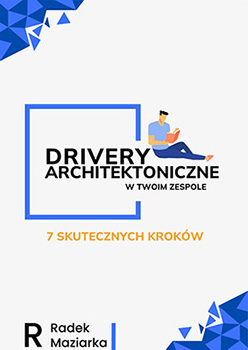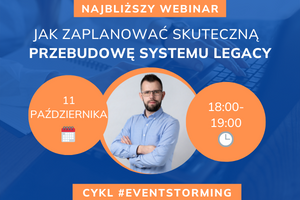// article written together with Piotr Klimiec – programmer at Software Mind.
Event Storming is becoming more popular and widely used in IT systems design. But, as I wrote in Event Storming – A tool that improves the organization’s work, it can also be applied in non-IT domains.
In this article, I would like to present how Event Storming has proven itself helpful in the analysis of such a non-IT domain - the recruitment process in a company of ~ 500 people.
Why is there a need for Event Storming in recruitment?
In many organizations, processes are created evolutionarily - no one plans them. They are adapted to the current situation on an ad hoc basis when there is a pressing need. The company is growing: 20 people, then 100, then 500, but no one wonders whether individual processes still work. If the business is profitable and pays employees on time - it means that everything is fine.
This very belief that everything is good and stable can result in ending up with a process that no one has any control over. Kind of like a ferocious monster that no one controls, but ultimately fulfills its purpose. Processes that run through multiple departments are particularly susceptible to becoming such beasts. Recruitment is a perfect example.
Various departments are usually involved in this process - HR, technical people, project managers, directors, managers, and the list goes on. Each participant in this process is but just a cog who has their own goals and is focused on achieving them. The HR department is supposed to set the standard, the manager is supposed to hire as cheaply as possible, and the technical person is supposed to count the lies in the candidate’s CV 😉. For each employee, the word ‘recruitment’ means something completely different.
If we do not set aside time to look at the entire process, we may end up pushing the responsibility onto others, just to avoid problems that do not directly concern us. In the long run, this tendency leads to the inevitable accumulation of tension between departments. Then we become a silo organization, which focuses on local optimization at the expense of global profits. And thus, we generate losses, both visible (e.g. costs of advertisements on portals) and invisible (e.g. time of technical people spent on job interviews).
So how can we verify a process as complex as recruitment is working properly considering it has different meanings depending on the department? It’s best to start by visualizing the entire process - and that’s where Event Storming comes in!
Before the Event Storming workshop
If you’ve ever conducted an Event Storming session, you’re bound to know that the hardest part is getting started - picking the suitable participants is not an easy task. Many people from various departments are involved in the recruitment process. Calendars must be coordinated well in advance to ensure everyone can find 4 uninterrupted hours to spare.
For many people unaware of this technique, the duration of the workshop was quite a surprise. “Why do we need 4 hours? What are we going to do for so long?” People who are accustomed to meetings in the style of “1 TV and 10 people looking at their laptops” were very surprised. Fortunately, Event Storming does not require participants to carry any electronics - we only need a set of post-it notes and markers.
In the organization process, it was very helpful to have a supporter in the form of a high-ranking person who could ‘encourage’ others to take part in the workshop. Without such an ally, the time needed to gather the group could be even longer.
Ultimately, the date of the first meeting was set for Friday, 1:00 p.m. - 5:00 p.m. From a psychological point of view, this is the worst possible time for strenuous mental effort. Some people thought it would start the weekend earlier. Unfortunately, it was the only choice we had ☹
Beginning the workshop
The workshop started with a clear definition of the goal - we want to understand how the recruitment process works. What does it look like from the point of view of individual departments, the amount of people involved, tools used in the process, etc.
The meeting was attended by 13 people, of which 10 had their first contact with Event Storming on that date. A short introduction, and explanation of how we would work, and after a while we started the session.
Big Picture – from a dump of all possible events existing in the recruitment process in the company:
Then we moved on to organizing the process by adding additional cards with problems and other elements.
An interesting observation was that people were initially afraid to flag Hot Spots (problems). They thought we would evaluate their work instead of the process. Problems could indicate that they are not competent enough to solve them by themselves. Some of the problems were a result of cooperation with another department, which could lead to department-to-department conflicts. With time, a safe atmosphere was finally established, and that allowed participants to freely share their doubts.
The second issue was that the participants wanted to prove that they were doing enough to ensure that the recruitment process was successful. As if each missing piece of paper could be a reason for them to be punished by the other participants. Fortunately, this state also did not last long. Ultimately, the group worked focusing on the goals of the workshop, instead of putting on a show.
These two issues show that during the workshop participants must build mutual trust, because only then will the group be able to work effectively and solve problems. The role of the facilitator and the appropriate selection of participants play an important role in this. Sometimes one wrong person in the room can block the rest of the participants, which directly affects what will be achieved during the workshop.
Results of the first session
The first session was a great success. Within 4 hours, we managed to visualize the entire process and discover several “buried bodies” placed underneath 😀 We mapped out everyone’s work, marked problematic places, and divided the process areas into smaller chunks.
However, we still had no clear answers on how to improve our process. We felt that a few more hours could help us achieve the results.
Conducting a second session
The results of the first session were so good that we immediately suggested having another one as soon as possible. While organizing the first workshop took 4 weeks, we needed only 5 days for the next one! The motivation and energy to act were so high that even synchronizing such a large group was no longer a problem. If people see that something works and makes sense, they will want to continue it.
During the second session, we worked on identifying problems and, if possible, addressing them with the support of Action Points. We marked all systems and actors involved in the process and looked at the model for potential improvements. Ultimately, the following effect was achieved:
The second session had a completely different dynamic than the first. During the first session, the participants needed time to adapt to this unconventional way of working, get used to the cards, gain self-confidence, and feel safe. During the second one, the right kind of energy was flowing from the very beginning!
Workshop results
The picture below shows the aftermath of 8 hours of effort (2 sessions of 4 hours each):
The result of the work was amazing - no one expected that so much would be achieved in such a short time. An overview of the entire recruitment process has been built, along with acknowledging its strengths and weaknesses. There were many issues to be faced, but the participants immediately suggested feasible solutions. We managed to define who is involved when, and at which point they leave the matter to others.
Every person in the room was pleased with the results. HR people were very surprised that their process was more effective than they thought. The technical people were happy after visualizing their difficulties because they could now work on them. The management staff saw the recruitment process so that they could then improve it.
People finished Event Storming with their hopes high. For the first time, they shared their problems with such a wide group, defined proposals for improvement, and who would take care of them. Some topics have been in the hearts of the company’s employees for a long time, but they kept silent about them. Thanks to the workshop, this too was resolved.
Summary
If it weren’t for Event Storming, it would not have been possible to conduct such a grand-scale meeting. After 8 hours we had the result ready. Each participant confirmed that it was time well spent. Some people even stayed after hours to share their impressions.
Non-technical people found this method very useful - everyone took an active part. People generally liked this technique - its lightness and the ability to adapt to their own needs. Immediately suggestions were raised to go through, for example, the on-boarding process of new employees. In our opinion, it seems that any business process can be visualized using this technique.
It seems we squeezed everything out of this topic😊
PS. If you are interested in Event Storming, I recommend my Event Storming workshops or checking other posts on this topic.









